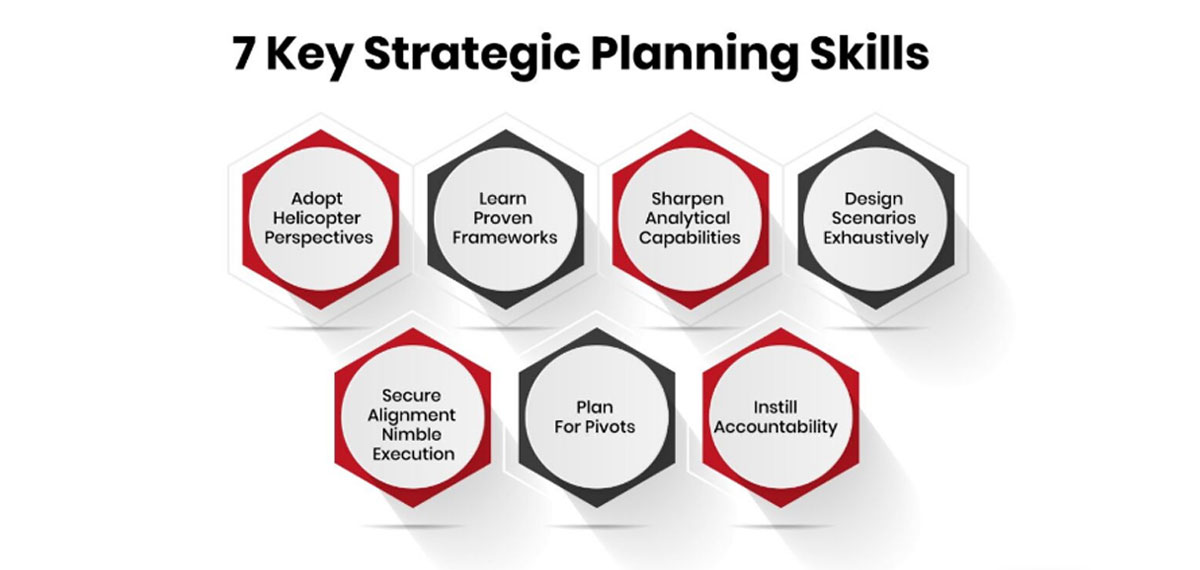7 Key Strategic Planning Skills for Business Success
 May 17, 2024
May 17, 2024
Deft strategic planning confers a sizable competitive advantage by sharpening enterprise focus, revealing blindspots early, and seamlessly aligning organization-wide efforts towards shared goals. Thus, honing strategic plan thinking capabilities becomes pivotal for leaders charting ambitious growth trajectories.
This blog covers why strategic planning matters, which underlying competencies it demands, and how professionals can systematically strengthen strategic acumen, steering their firms to unprecedented heights.
Why Does Strategic Planning Matter?
Strategic planning is a critical process that helps organizations define ambitious yet achievable long-term goals and lay out step-by-step roadmaps to reach them. It provides immense value in several key ways:
-
Channels Energy Towards Key Goals
Strategic planning brings a sharp focus on the handful of make-or-break goals that matter most for an organization’s success. This prevents resources and efforts from getting diffused across less impactful peripheral initiatives that merely seem urgent. Strategic planning sets apart the vital few from the trivial many.
-
Anticipates Emerging Risks and Opportunities
By mandating that strategy designers envision potential scenarios - both positive and negative - strategic planning builds organizational agility and resilience. It prompts proactive identification of looming threats that may require contingency planning. Similarly, it reveals openings for first-mover advantage through breakthrough initiatives in adjacent spaces.
-
Ensures Organization-wide Alignment
By transparently communicating enterprise-wide priorities identified through systematic strategic planning, organizations resolve departmental misalignments where siloed units may otherwise work at cross purposes. It brings coherence to collective efforts.
-
Enables Course Corrections
The regular reviews and progress tracking processes inherent in strategic planning cycles allow organizations to rapidly detect early signals when realities deviate materially from projections. This allows timely course corrections through informed pivots, saving precious time and resources.
Meticulous strategic planning ensures budgetary, talent, and operational capabilities get efficiently channeled towards differentiated goals and minimize waste. Pitfalls like over-investing in non-core activities or duplicative competing efforts are averted through judicious allocation.
-
Attracts Top Talent
By boldly articulating an ambitious vision for the future, organizations inspire both current and prospective talent. Employees feel pride in contributing to outsized goals and team bonds while overcoming shared challenges. An aura of pioneering spirit retention and recruitment.
In summary, separating hype from reality, strategic planning confers durable competitive strength to firms intentionally building this organizational capability. It is no panacea but ignored at one’s own peril. With disciplined adherence to its tenets and principles, business strategy unlocks immense latent potential for teams aligned around inspirational goals empowering their future.
What Competencies Shape Strategic Planning Excellence?
While different models exist, several fundamental capabilities remain vital for any successful strategic planning approach. Mastering these multidimensional strategic planning skills separates mediocre incrementalists from transformational strategic thinkers driving enduring growth.
Diagnostic Acumen
Strategic leaders boast the perceptiveness to read weak signals within steady trends and see early warnings of impending changes ahead of peers. Key aspects include:
-
Subtle Pattern Spotting - Identify nuanced inflections in contextual factors from subtle cues. This allows for an accurate assessment of situational dynamics.
-
Transition Sensing - Spot transitions from one maturity stage to another in the market lifecycle curve by analyzing business growth patterns.
-
Opportunities/Threats Detection - Uncover latent niche opportunities or existential threats in the longer term from seemingly random data points today.
Systems Thinking
Top strategic thinkers conceptually connect disparate dots, creatively configuring them into ambitious yet viable future systems displaying seasoned judgment.
-
Future Conceptualization - Design structured goal scenarios expanding capabilities balancing realism with idealism avoiding incrementalism.
-
Inspirational Visioning - Portray desired future states vividly, appealing at emotional levels to rally collective spirit.
-
Contingency Planning - Codify crisis response protocols for extreme scenarios, from wild card events to liquidity crunches.
Change Leadership
Beyond technical analysis, strategic leaders leverage political and cultural change management savvy to drive transformation.
-
Stakeholder Alignment - Overcome resistance by appealing to the interests/values of influencers and securing requisite buy-in.
-
Motivational Communication - Share reality while restoring hope, conveying authentic confidence in the collective capacity to prevail against challenges.
-
Sustained Commitment - Remain resilient in adherence to strategic direction without wavering or diffusion during uncertainty typical of transitions.
Flawless Alignment
Ensuring strategic priorities in shared goals cascade down enterprises simplified into specific accountabilities prevents disjointed efforts.
-
Goals Breakdown - Granularly decompose top-level goals into departmental, team, and individual OKRs enterprise-wide.
-
Conflict Resolution - Foster harmony across functions by jointly resolving differences that hinder cross-departmental collaboration.
-
Interdependence Identification - Intentionally structure workflows by identifying touchpoints demanding enterprise-wide synchronization.
Results Orientation
Instilling zeal for surpassing existing standards avoids complacency, while progress bars continually elevate as organizations evolve capabilities over time.
-
Stretch Metrics - Institutionalize a chronic sense of constructive discontent with the status quo fueled by hunger for ambitious stretch goals.
-
Ruthless Prioritization - Maintain unwavering focus on outcomes without distraction by peripheral matters or pet initiatives.
-
Virtuous Progression - Raise performance bars as competencies strengthen in perpetuity while celebrating small wins, shaping a culture of excellence.
Together, these diverse but symbiotic capabilities make for strategic planning proficiency at scale, distinguishing outperforming entities. While ingrained early in childhood, components can be systematically nurtured later through dedicated grooming.
7 Ways Professionals Can Level Up Strategic Planning Skills
For both individuals and organizations seeking strategic planning elevation, the following are 7 actionable tactics:

1. Adopt Helicopter Perspectives
Rather than getting mired in granular everyday details, consciously zoom out to spot emerging sector patterns promising first-mover advantages or reductionist tactics missing the big picture.
-
Carve out contemplation time pondering existential questions facing business.
-
Debate strategy priorities with thought leaders beyond usual peer circles.
-
Map core assumptions driving decisions and stress test them.
2. Learn Proven Frameworks
While no formulaic solutions exist in strategy, time-tested models provide guardrails for avoiding previous pitfalls.
-
Master renowned foundations like Porter’s 5 Forces, SWOT, PESTEL, etc.
-
Audit past successful and failed initiatives, discerning differentiating factors.
-
Enroll in formal strategy programs offered by leading faculties.
3. Sharpen Analytical Capabilities
Help cohorts sift signals from noise by honing fact-based evaluation proficiency.
-
Take courses elevating statistical analysis, financial modeling, and data science skills.
-
Take up puzzles and participate in case competitions, building cognitive muscles.
-
Take up advisory roles guiding strategy for early-stage ventures.
4. Design Scenarios Exhaustively
Stress test growth plans by charting scenarios spanning best, worst, and most likely cases given identifiable conditions.
-
Use techniques like simulation modeling to form probabilistic assumptions.
-
Red team proposed ideas of having contrarians poke holes, unearthing hidden flaws.
-
Benchmark against analog contexts where similar plays unfolded successfully or flopped.
5. Secure Alignment Nimble Execution
Foster coherence across layers via transparent communications while empowering teams executing plans through distributed authority.
-
Cascade goals into specific accountabilities across the hierarchy, preventing diffusion.
-
Equip frontline colleagues closest to market realities with autonomy, taking decisive actions.
-
Encourage surfacing deviations from projections quickly without fear of repercussions.
6. Plan For Pivots
In dynamic times, planning must evolve from rigid roadmaps to flexible playbooks deftly adapting momentum.
-
Build contingency responses for high-impact scenarios rather than dismiss them as improbable.
-
Accept key assumptions will be invalidated and represent temporary best knowledge.
-
Maintain war chests, allowing capitalization should breakthrough opportunities arise.
7. Instill Accountability
Celebrate milestones met by linking progress to formal incentives and informal recognitions, enhancing morale.
-
Quantify contributions via OKR goal fulfillment over relativistic model rewards.
-
Share stories of teams overcoming setbacks through grit rather than glory for successes alone.
-
Discuss missteps openly as learnings without ascribing blame.
Combined, such steps ingrain strategic planning excellence at individual and organizational levels, promising prudent vision setting and flawless execution.
Summing Up
The capacity to formulate robust strategies and align collective efforts toward ambitious targets represents an invaluable capability conferring market leadership. By studying concepts, shaping strategy, honing supporting skill sets, and applying learnings through guided practice, professionals unlock coveted strategic planning mastery, elevating their leadership impact and accelerating their ascent up organizational ladders.


